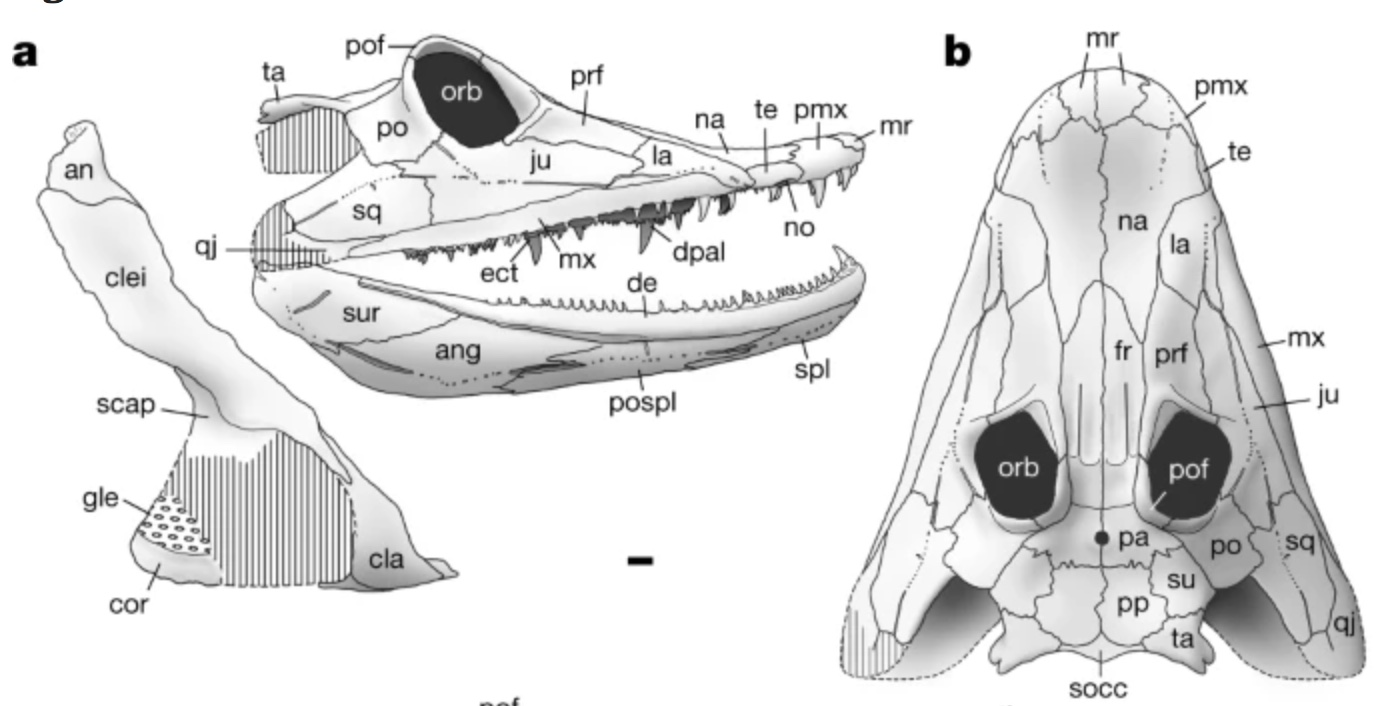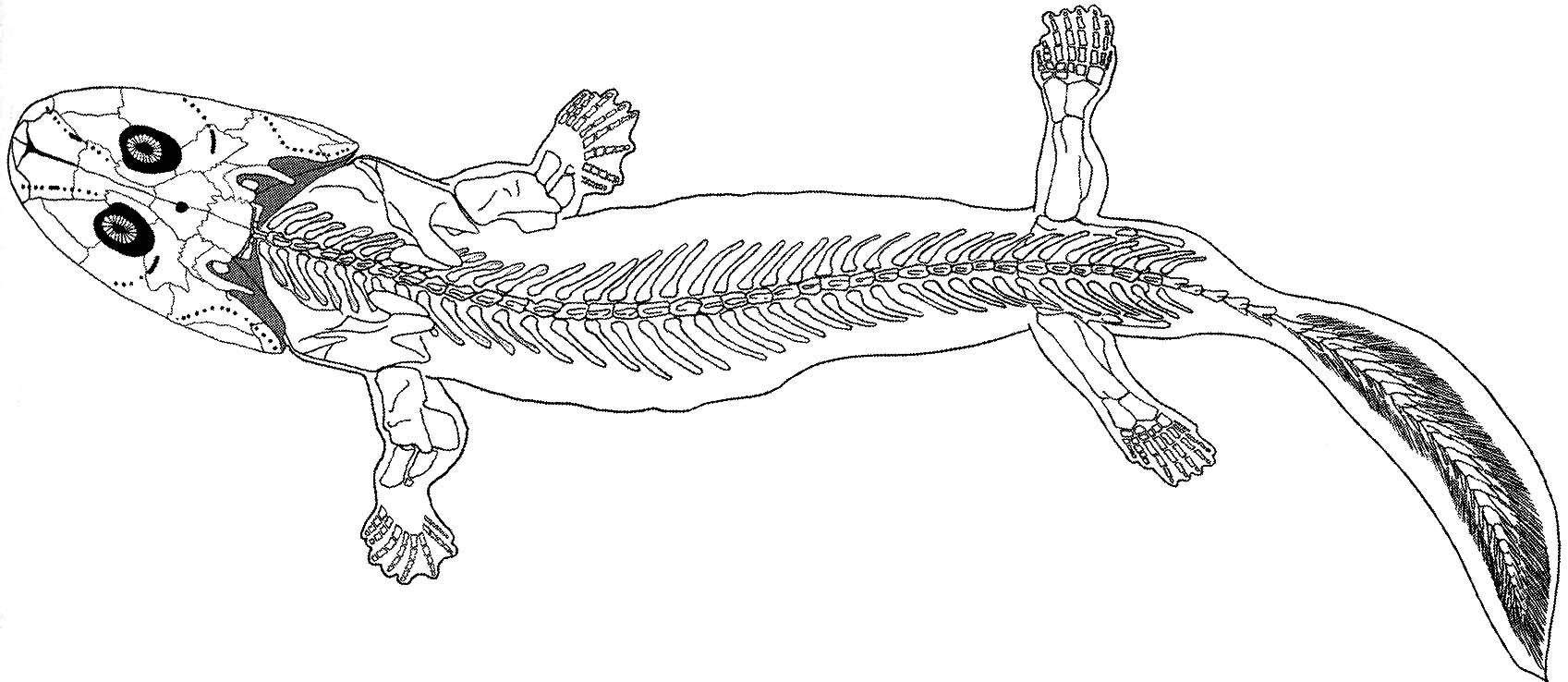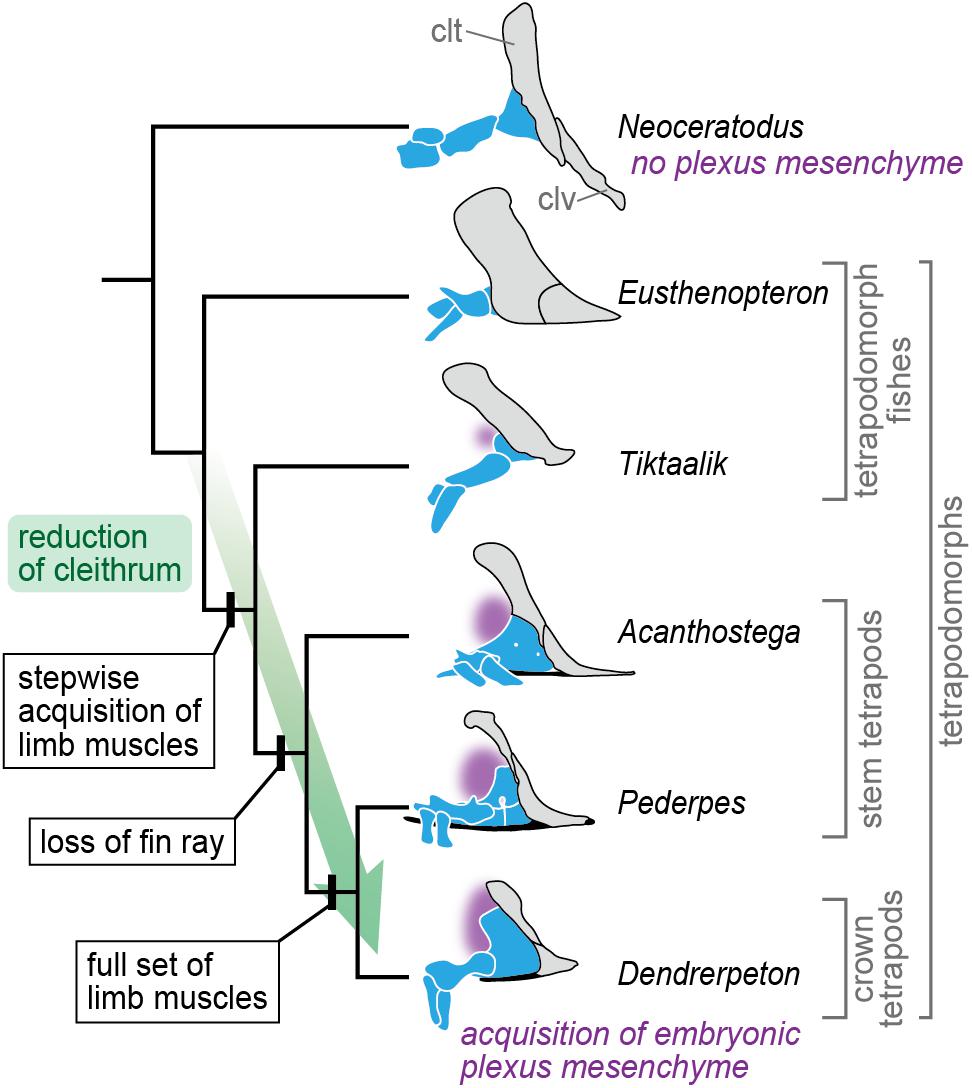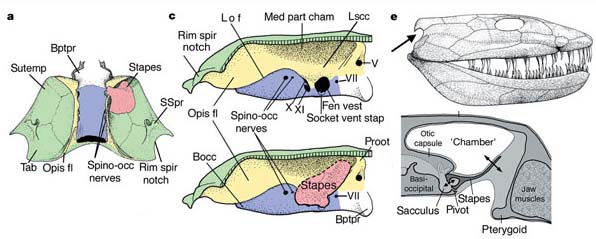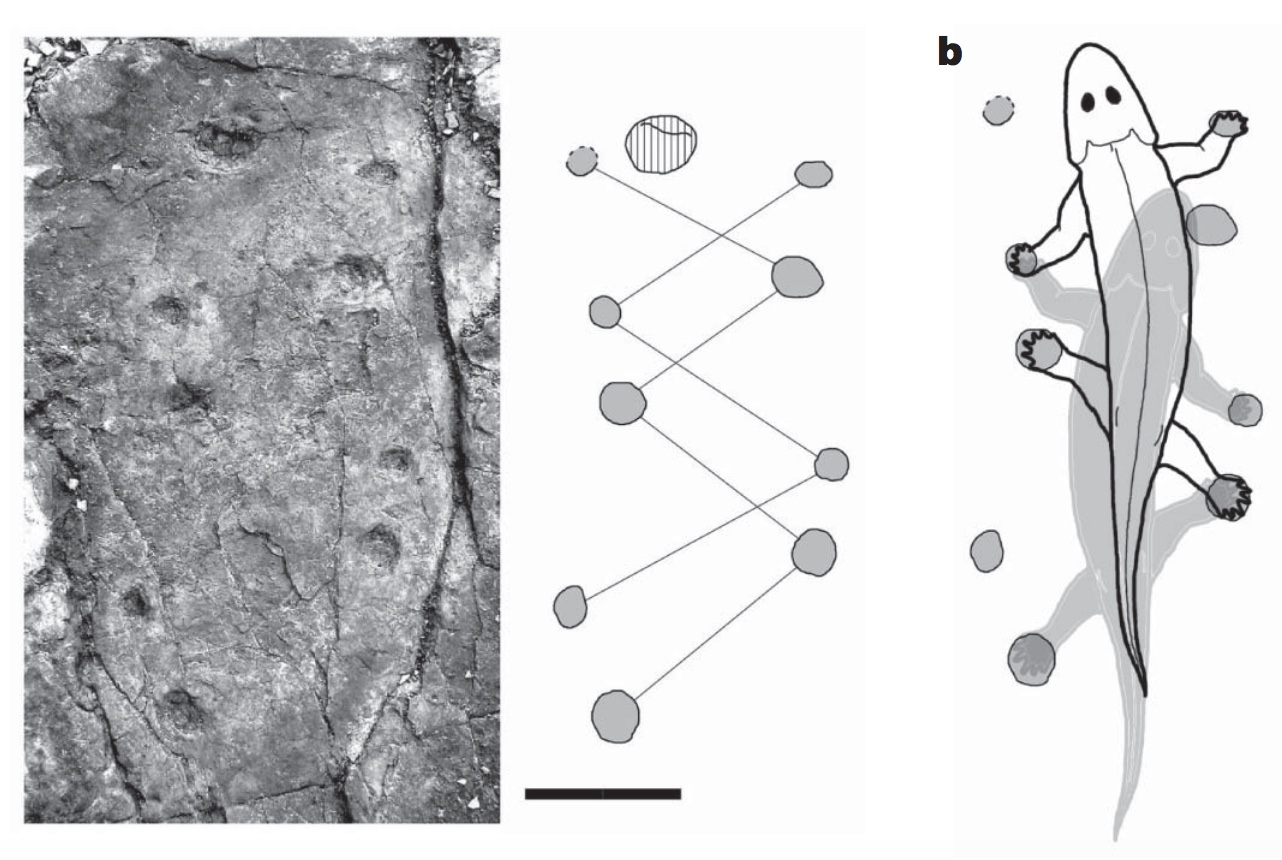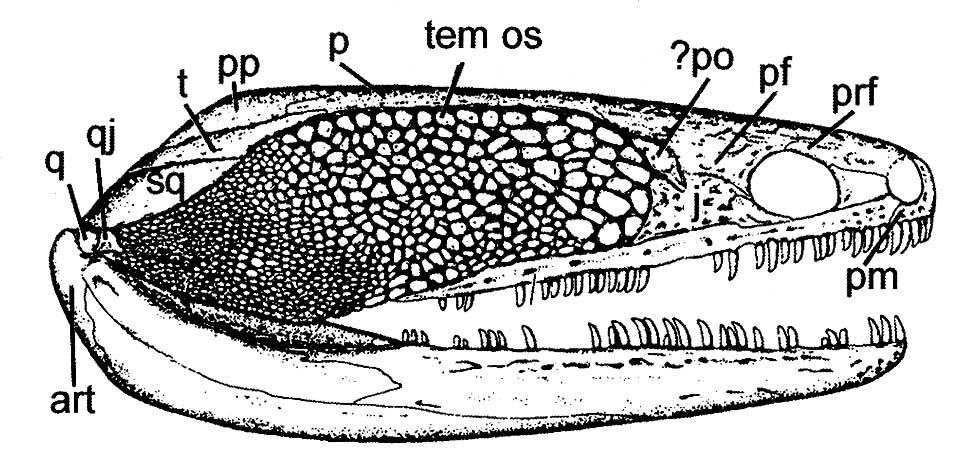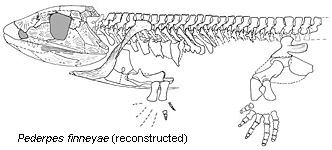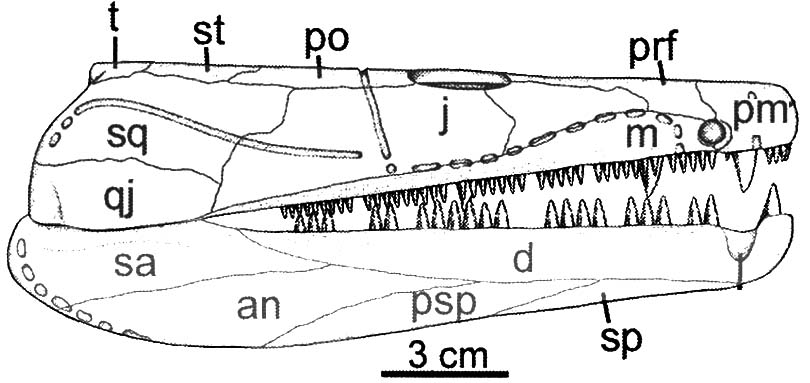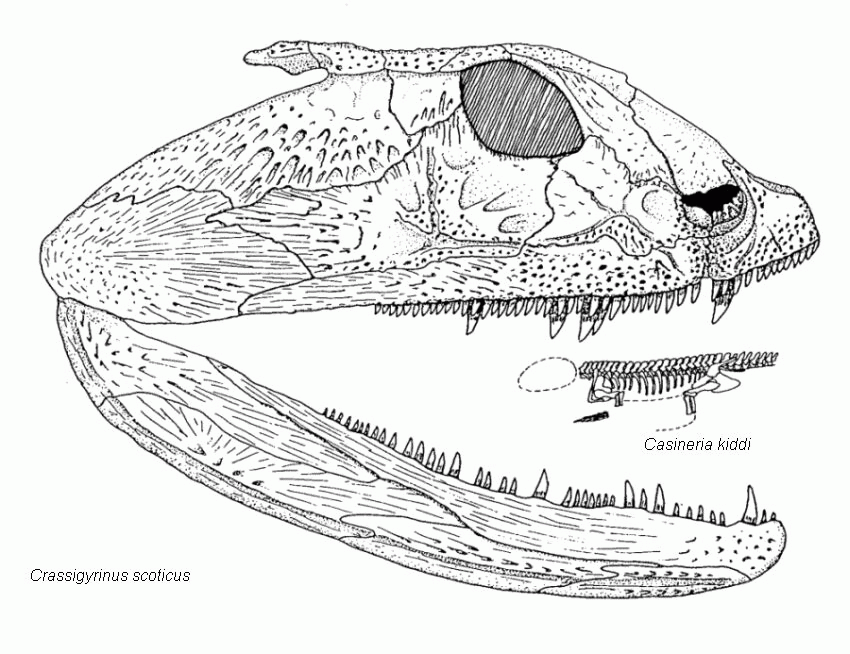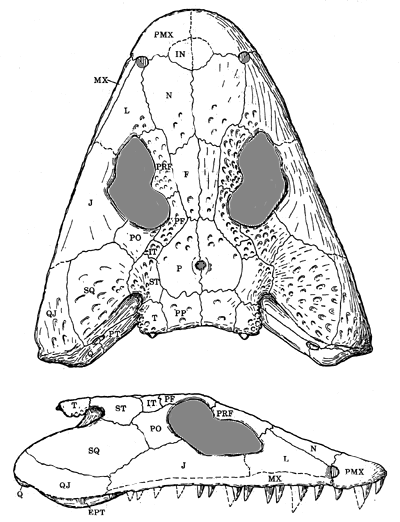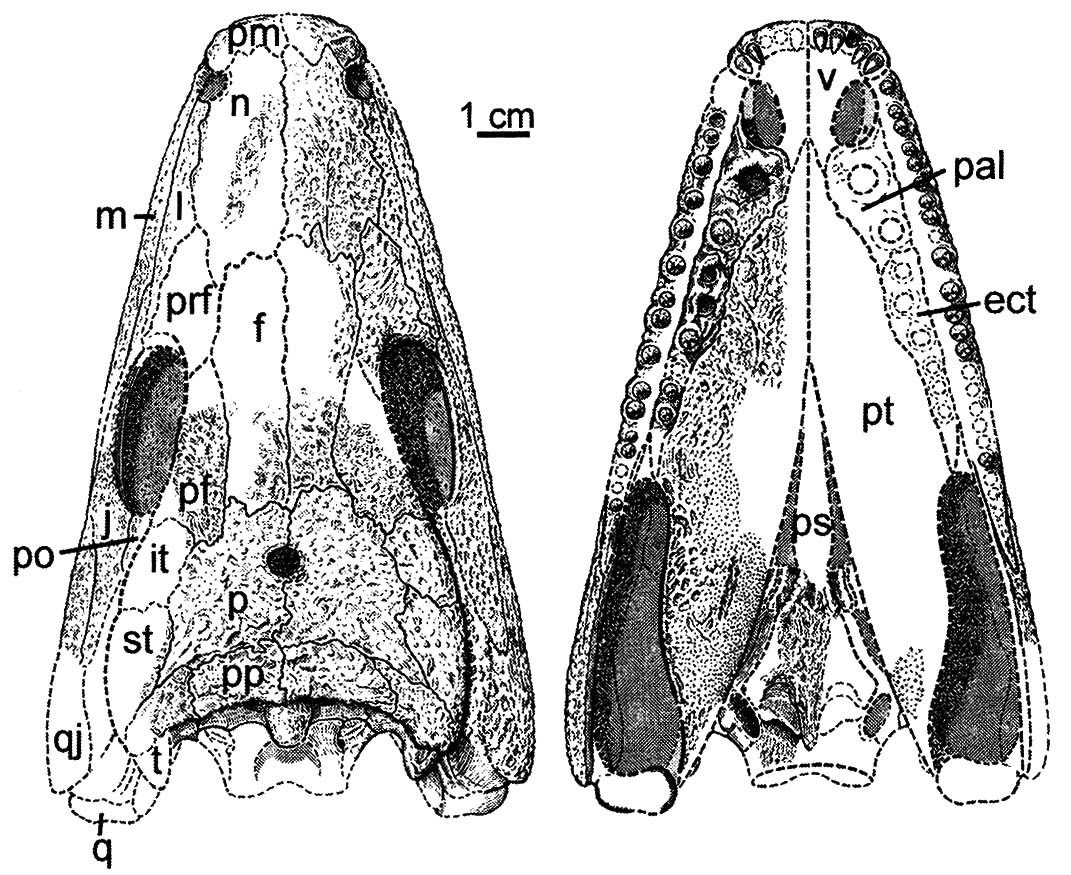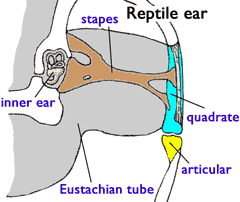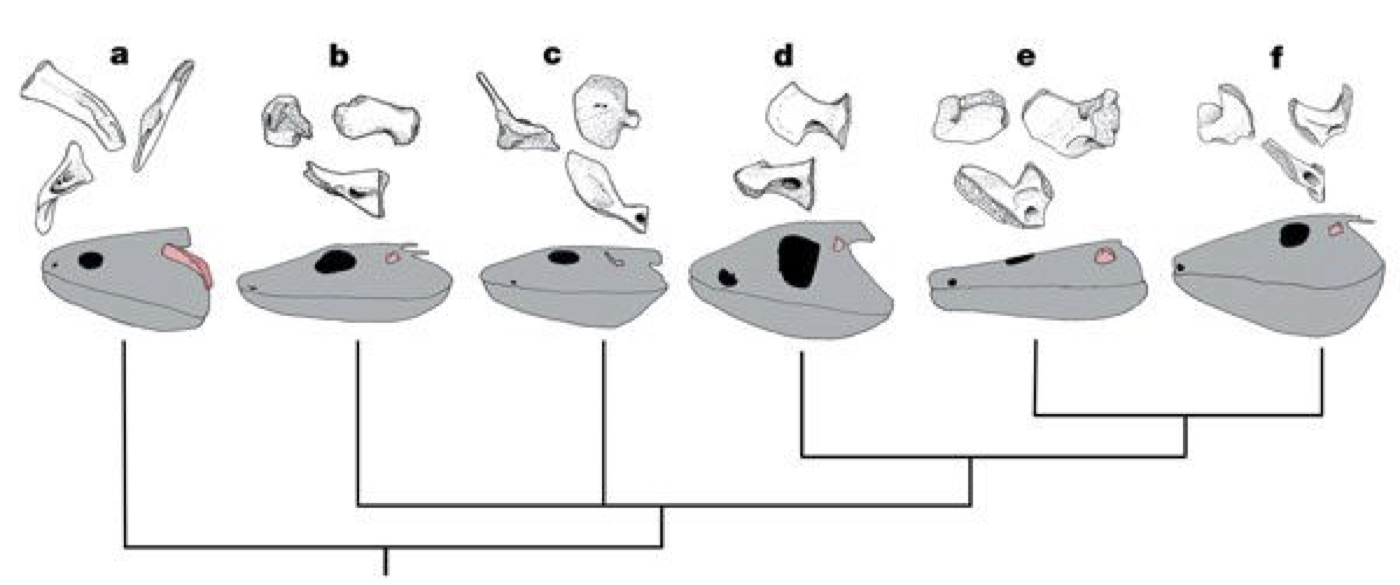Origin of Tetrapoda
Elpistostegalia becomes "digitized"
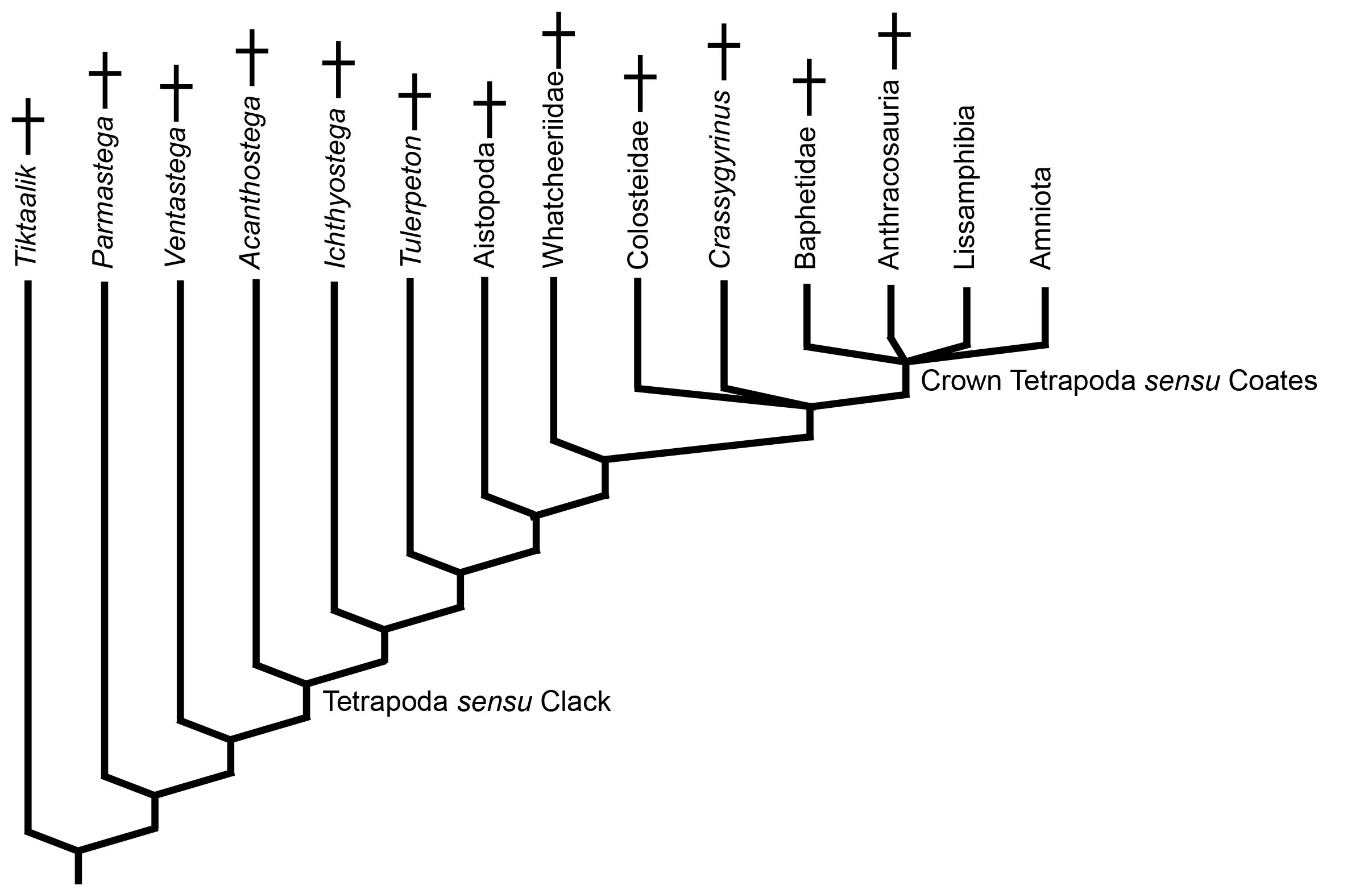
Parmastega has enlarged, dorsally placed orbits, and seems to have hunted with its eyes and skull table protruding from the water. It's nostrils faced downward, but like other elpistostegalians, it could have breathed through its spiracles. It's forelimbs aren't preserved, but its pectoral girdle resembles those of later elpistostegalians with digits. Known only from its skull and girdle elements, Parmastega lacks opercular elements and the dermal pectoral elements dorsal to the anocleithrum. Thus, like Tiktaalik, it had a neck of sorts. Potential synapomorphy with Tetrapoda:
- Paired nasals
When we meet elpistostegalians again in the latest Devonian, O2 concentrations had returned to familiar levels, but air-breathing adaptations had not gone away. Progressing into the Carboniferous - the "Age of Oxygen," the atmosphere became the place for easy access to O2, creating a selective pressure to exploit air-breathing abilities.
We now encounter creatures with very tetrapod-like heads including Ventastega curoni (Ahlberg et al., 2007).
What kind of appendages attached to the pectoral girdle? Unknown. Fortunately in the next case, it is not.
Very well known from relatively complete skeletons. The first and phylogenetically most basal vertebrate definitely to possess fingers and toes! Synapomorphies with Tetrapoda include:
- Nasals nearly touch on mid line (although a narrow internasal fontanelle remains.)
- Ethmosphenoid and otico-occipital components of neurocranium are fused. Intracranial hinge obliterated.
- Pharyngeobranchials lost.
- Fingers and toes present
Acanthostega's neurocranium at last begins to resemble that of a tetrapod. Note:
- Distinct basipterygoid processes compared to what we have seen previously.
- Ventrally, the lateral cranial fissure manifests as a large vestibular fontanelle (fen vest right).
But was it a fish? Consider the transformations listed at the beginning of the lecture:
- Breathing
- Osteology of the pectoral girdle tells us that an open operculum and functional gills were present in adult. (Although they were reduced slightly in size by the loss of phanyngeobranchials. (Schoch and Witzmann, 2011.)) Specifically:
- Ceratobranchials were grooved posteriorly to accommodate branchial arteries
- The cleithrum had a clear postbranchial lamina.
- The tabular enclosed a large spiracular opening.
- Osteology of the pectoral girdle tells us that an open operculum and functional gills were present in adult. (Although they were reduced slightly in size by the loss of phanyngeobranchials. (Schoch and Witzmann, 2011.)) Specifically:
- Mechanical support
- Flexibility of forelimb
- As modeled digitally by Molnar et al., 2021,
- strength of humerus retraction is intermediate between that of lungfish and Eusthenopteron and of living tetrapods, suggesting some ability to generate force against a substrate.
- The elbow joint is highly mobile
- But the humerus can't be rotated to anything like the extent of living tetrapods.
- Slightly flexible elbow and knee.
- Fin rays lost from all but the caudal fin
- Fingers (eight per limb) and toes (seven per limb) present.
- accessory articulations between neural arches, but no zygapophyses to speak of.
- Pelvis is small but has a ligamentous connection with a sacral rib.
- But note: It is not merely the presence of digits and mobile joints that makes a terrestrialized limb. The number and mass of muscles and nerves to overcome them has to increase significantly. Hirasawa et al., 2021 investigated the development of the forelimb in the Australian lungfish Neoceratodus, finding that a limiting factor to forelimb enlargement was that amount of mesenchyme able to migrate into the limb to form its peripheral nervous system. The early ossification of the cleithrum seems to form a barrier to mesenchyme migration, limiting forelimb mass. Consequently, the elaboration of the forelimb was coupled evolutionarily with reduction of the dermal cleithrum.
- Feeding:
- Skull and pectoral girdle detached.
- First vertebra is enlarged, but otherwise no specialization of the vertebral column, such as zygapophyses.
- Skull and pectoral girdle detached.
- Senses:
- Extensive lateral line system
- Unlike in other gnathostomes we have considered so far, the foot-plate of the hyomandibula rests in the vestibular fontanelle, rather than articulating to a solid facet on the neurocranium. In better-known tetrapods, this is how sound is transmitted to the otic capsule. When it takes on this function, the opening is known as the fenestra vestibuli or fenestra ovalis.
The overall impression is of a fully aquatic animal with rudimentary ability to support some body weight on fore and hindlimbs and with the beginnings of the ability to use its jaw and hyoid arch to pick up sound from the ground. Maybe it came onto land occasionally to feed, disperse to new habitats, or thermoregulate, but it was primarily an aquatic animal. What did it use its fingers and toes for? Maybe not much at all. As with the origin of lungs in Osteichthyes, Byrne et al., 2020 speculate that the evolution of digits might be a response to high tide ranges and the hazards of becoming trapped in tide pools.
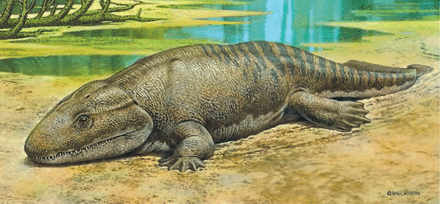
Ichthyostega stensioi
Very well known (even in popular culture of previous generations: See Album cover of Yes' "Tales of Topographic Oceans" by Roger Dean) from relatively complete skeletons, but redescribed by Ahlberg et al., 2005.
- Breathing
- Small detached opercular element and grooved ceratobranchials remained (Clack et al., 2003), indicating that it breathed using internal gills.
- Mechanical support
- Ribs are long broad and overlapping, limiting ability to curve spine laterally either in water or on land. Instead, the regions of the vertebral column are specialized, sort of like in a mammal. Implication is that spine was flexed up and down.
- Zygapophyses present. (But note the reversed positions of intercentra and pleurocentra!)
- Pelvis robust in comparison to all aquatic vertebrates, with direct articulation with sacral rib.
- Ribs are long broad and overlapping, limiting ability to curve spine laterally either in water or on land. Instead, the regions of the vertebral column are specialized, sort of like in a mammal. Implication is that spine was flexed up and down.
- Seven toes present, as in Acanthostega. The earliest creatures with fingers and toes had the developmental ability to generate them, but had not yet evolved the ability to stop making them when they had enough.
- Flexion of elbow and knee joints limited. The limbs seem to have functioned primarily as paddles.
- Feeding:
- Skull and pectoral girdle completely detached. Dermal pectoral series dorsal to the cleithrum completely lost.
- But there is still a pit for the notochord in the basioccipital condyle, limiting head's ability to flex.
- Senses:
- Lateral line system remains present
- The hyomandibula is weird in this animal, being very broad, flat and thin. Apparently is had some unique function that is not seen in living vertebrates. Clack et al., 2003 speculates its flat surface rested against an air-filled chamber in the spiracular passage, picking up airborn vibrations and transfering them to the otic capsule via the fenestra vestibuli. In that way, it functioned analogously to an eardrum in an early attempt at an impedance-matching ear. In that case, how likely is it that Ichthyostega also had an ear-drum?
- Lateral line system remains present
- Reduced operculum
- strengthened vertebral column
- reduced ability to flex body laterally
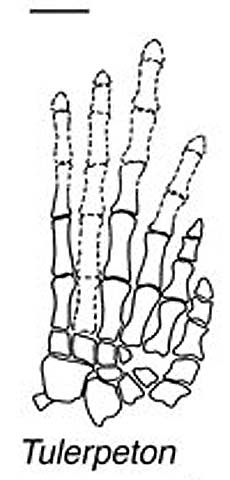
Tulerpeton curtum scale bar = 1 cm.
- Absence of evidence for an open operculum.
- A six-fingered hand
Elegant Hypothesis - Brutish Facts: We have constructed an attractive and coherent picture of the steps in the acquisition of tetrapod-like attributes:
- Late Devonian oxygen concentration crisis stimulates the evolution of enhanced air-breathing in elpistostegalians.
- Latest Devonian acquisition of limbs with fingers and toes combines with existing air-breathing habits to yield a vertebrate capable of venturing onto land.
-
Middle Devonian trackways: The footprints of quadrupedal creatures with fingers and toes are known from several localities around the world. Although the geologic age of many are poorly constrained, some (see Niedzwiedzki et al., 2010) are plainly Middle Devonian - i.e. 18 my older than Acanthostega. WTF? Apparently Elpistostagalia encompasses some substantial ghost lineages.
Romer's Gap - a geologic enigma: Acanthostega and Ichthyostega lived roughly 365 mya. The earliest known members of the lineages leading to Lissamphibia and Amniota are from roughly 335 mya. For some reason, the first 30 my of the Carboniferous were a dark age in which fewer were preserved as fossils or paleontologists haven't found the correct rocks. (Note: a similar contemporaneous gap exists for fossil insects.) Thus, we are in the dark about how quickly vertebrates actually used their hands and feet to get out of the water. Even after Romer's Gap ended, most "land vertebrates" remained aquatic with weak limbs and prominent lateral line systems.
Chastened, we consider the Carboniferous: Remember, the latest Devonian "digitized" elpistostegalians weren't, as far as we can tell, really using their digits for much. From these beginnings, creatures had three general options:
- Reduce or eliminate limbs and digits
- Continue to not specialize (ignore) them
- Develop them for new functions
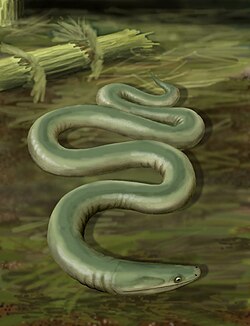
Oestocephalus amphiuminus
(Early Carboniferous - Early Permian) Superficially snake like, elongate, and limbless (Although Phlegethonia retains a cleithrum in the pectoral region (Anderson, 2002). Long regarded as members of crown Tetrapod, Pardo et al., 2017 found to be early stem tetrapods (ironically) based on ancestral features including:
- Presence of a notochord recess in place of basioccipital condyle.
- Open lateral cranial fissure
- Persistent hypophyseal duct opening in palate.
Skulls are significantly modified, with orbits shifted far anteriorly and jaw articulation shifted posteriorly resulting in the great elongation of the temporal region. What's particularly strange is the reduction and fragmentation of the dermal bones of the temporal region. To compensate for the loss of mechanical strength that this implies, the palatoquadrate actually ossifies as a single unit.
Aistopod vertebrae are holocentrous, however Lethiscus, from the Early Carboniferous, was found by Anderson et al., 2003 to retain distinct intercentra and pleurocentra. It seems to be the most primitive aistopod. Alas, being so highly derived, the paleobiology of aistopods is difficult to interpret. Because descriptions of branchial arches and pectoral girdle (such as it is) are lacking, we can't even assess whether they were primarily air breathing.
Whatcheeridae: Clack, 2002 described Pederpes finneyae of Britain, from the middle of Romer's Gap at 350 mya. Although it retains a tiny sixth finger, has a robust lateral line system, a heavy hyomandibula/stapes, and retains a preopercular; it also has robust limbs and a skull that is compressed from side-to-side like early land vertebrates. It and close relative Whatcheeria comprise the Whatcheeriidae (Latest Devonian - Early Carboniferous). We don't know how much time they spent on land, but they seem, at least, to have been able to walk - a new development fifteen million years after the evolution of hands and feet. Otoo et al., 2021 note that in comparison to other basal tetrapods, whatcheeriids have extremely large robust limbs, but that they present plausible adaptations to aquatic life. On the other hand, Molnar et al., 2021 note that in their simulations, Pederpes is only slightly advanced over Acanthostega.
Early Carboniferous Landmarks: Emerging from Romer's Gap, we pick up several lineages. Their synapomorphies:
- The preopercular - the last vestige of the dermal opercular skeleton - is lost.
- Opening of the hypophyseal duct in parasphenoid lost.
- Notochordal pit in basioccipital is lost.
Colosteidae: (Carboniferous) Including the familiar Greererpeton. All are elongate with small limbs whose joints are formed in cartilage. They retain extensive lateral line systems, and some have gill-rakers on their ceratobranchials, indicating an open operculum and suspension feeding as an option (Schoch and Witzmann, 2011). Distinctly fresh-water aquatic. Distinctive features:
- Spiracular notch is lost. (Spiracle likewise?)
- Prefrontal extends to margin of naris
- Premaxillary fang fits in notch in dentary
Crassygyrinus scoticus: (Early Carboniferous) Very strange:
- The body is elongate with a deep tail.
- Hindlimbs are small, forelimbs positively puny.
- Sacral articulation lost
- Vertebral column is poorly ossified, with poorly developed zygapophyses.
- Reconstructed by Clack, 1998 and Panchen 1973 as having a laterally compressed head such that the eyes definitely looked to the side. Reanalysis by Porro et al. 2015 indicates that this is exaggerated and that the head was actually flatter.
- Models of jaw joint indicates a gape of up to 60 degrees.
- A distinct spiracular notch
- A midline trough on the snout, the intermaxillary fenestra. Is this the internasal fontanelle we saw in Ventastega?
Baphetidae:(Carboniferous) A morphologically disparate but distinct clade of aquatic predators. Known since the 19th century from skulls but hardly any postcranial material. Plesiomorphic in retention of full lateral line system and distinct spiracular notch.
Synapomorphies:
- Solid palate with closed interpterygoid vacuities and coossified basipterygoid articulations.
- Key-hole shaped orbit with embayment of the lacrimals and prefrontals.
- a gland?
- a fenestra to accomodate bulging muscles?
Baphetid diversity: encompasses several ecomorphs.
- Eucritta melanolimnetes (Early Carboniferous) The most basal baphetid. Surprisingly small (~25 cm) and with only a hint of the key-hole orbit.
- Megalocephalus with a superficially crocodile-like skull up to 35 cm long. The largest of a range of fish-eating aquatic predators. In it, the basipterygoid articulation becomes a solid suture uniting palatoquadrate and neurocranium.
- Spathicephalus: Evidence of hidden diversity. Shovel-headed with exaggerated key-hole orbits and unprecedented dentition of many chisel-like teeth that don't appear to undergo replacement, and no palatal teeth at all. Could this be a ram-suspension feeder (like a baleen whale)? In all its weirdness, on tends to overlook that it, too, fuses the basipterygoid articulation.
Phylogenetic analyses place baphetids either below the base of crown Tetrapoda or as basal members of the Lissamphibian stem. A potential synapomorphy of baphetids and the lissamphibian line: A slender hyomandibula suspended in the spiracular chamber - except now we can start saying "A slender stapes suspend in the middle ear."
Anthracosauria: (Carboniferous - Triassic) Aquatic to mostly terrestrial vertebrates of the late Paleozoic. Although this groups membership varies with each new publication, it seems monophyletic.
Identifying characters:
- The tabular contacts the parietal and develops elongate "horns" at the posterolateral corner.
- The cheek lies adjacent to the skull roof along a kinetic line.
- There is no clear spiracular notch, and the stapes is heavy. Sensory canals present in the skulls of many.
- Two - three fenestrae perforate the medial surface of the jaw.
- Pleurocentra larger than intercentra . Both assume a horseshoe or disk shape.
Relationships: Until recently seen as the basal members of Reptiliomorpha. Some characteristics, including the tabular parietal contact and the large pleurocentra are shared with other reptiliomorphs, including amniotes. However recent analyses have placed them outside of Tetrapoda, in part due to the persistence of plesiomorphies like caudal fin rays (Clack, 2011).
Final word:
Stem tetrapods are paradoxical. All show adaptations indicating increased reliance on air-breathing, the hearing of airborne sound, and some may have routinely walked on land: however:
- Acanthostega, Greererpeton, Whatcheeria, and Megalophalus, all display osteological correlates to the presence of internal gills (Schoch and Witzmann, 2011).
- Modeled limb dynamics indicate that they lacked the land locomotion abilities of living tetrapods. (Molnar et al., 2021)
- Studies of anisotropies in limb bone cross-sections reveal that limb bones of creatures of Acanthostega, Pederpes, and embolomere grade resemble those of living aquatic tetrapods. (Lennie et al., 2021)
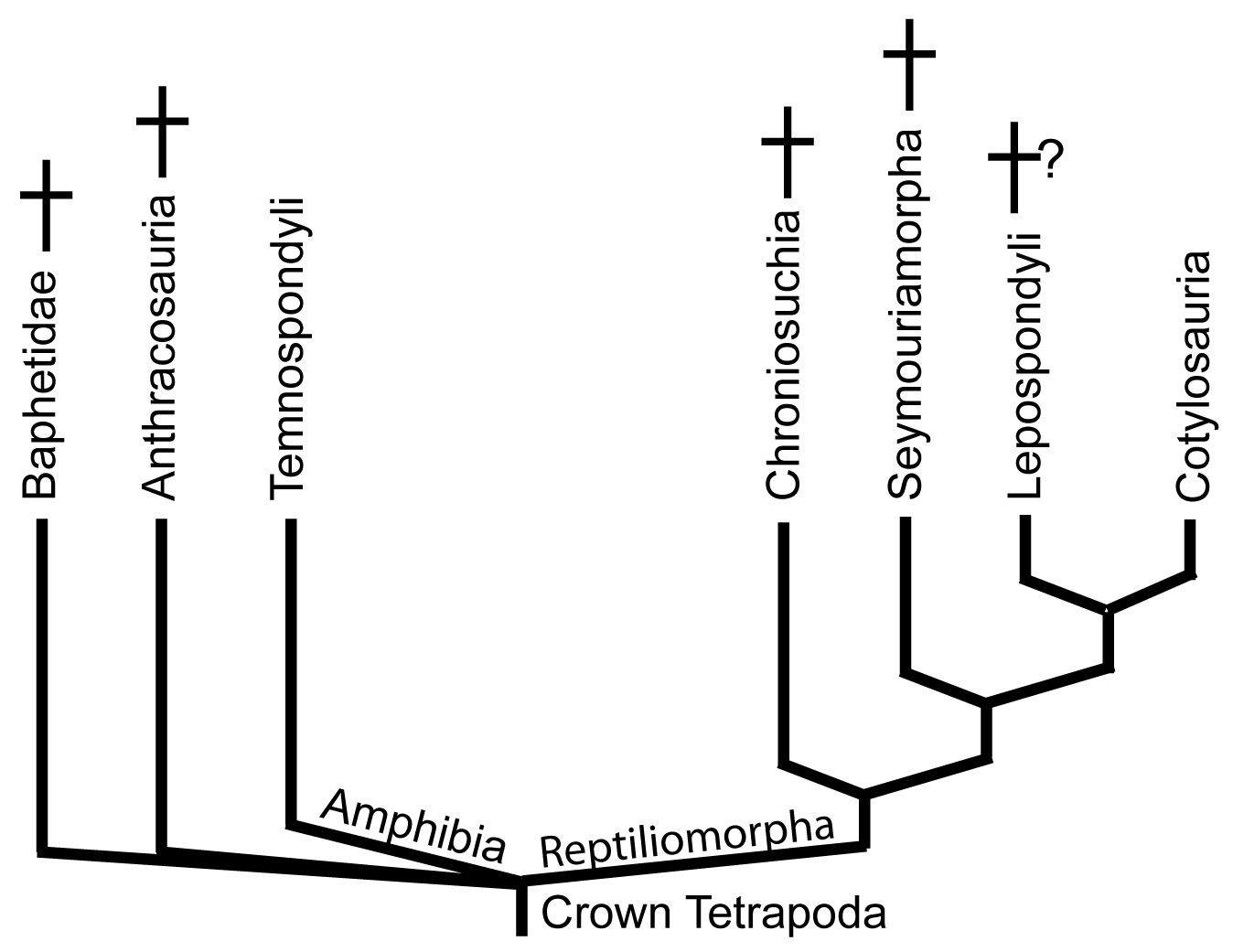
Tetrapoda: Opinions vary as to where this name should be stuck to the tree:
- Clack, 2012 feels that excluding creatures with hands and feet from a group whose name means "four feet" is perverse. For her, Tetrapoda has is a classic "apomorphy-based definition."
- Coates et al., 2008 favor restricting the name to the "crown group" - i.e. the node-based group defined as the last common ancestor of living members of the group.
Synapomorphies:
- First two cervical vertebrae specialized as the atlas and axis. These facilitate movement of the head on the neck.
- Not a synapomorphy, exactly, but somewhere before Tetrapoda, the number of digits on manus and pes had stabilized at five.
Phylogeny: Tetrapoda consists of two major lineages with living members:
- Amphibia: (total-group) All organisms more closely related to frogs, salamanders, and caecilians than to Amniota.
NOTE: This use of the term "Amphibia" excludes creatures like seymouriamorphs and lepospondyls, even though they might have ecologically resembled modern amphibians.
- Lissmphibia: (Crown-group) The last common ancestor of living amphibians (frogs, salamanders, and caecilians) and all its descendants.
- Reptiliomorpha: (total-group) All organisms more closely related to Amniota than to Lissamphibia.
NOTE: Some creatures in the reptiliomorph total-group, might have ecologically resembled amphibians despite their evolutionary propinquity to amniotes.
- Amniota (Crown-group) The most recent common ancestor of mammals and birds and all of its descendants.
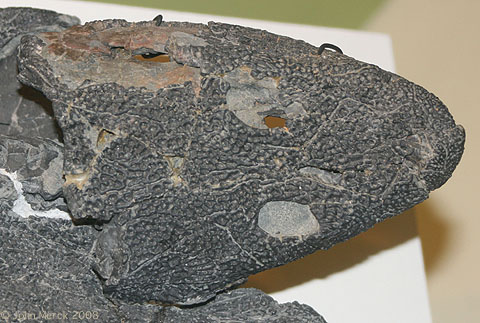
Greererpeton burkemorani
- Lateral line sense: Useless out of water. Thus, they are quickly lost in creatures that spend most of their time on land. Although not always preserved as bony sensory canals, the presence of such is a clear indicator of aquatic life-style.
- Hearing: Acoustic impedance is the resistance of a system to the flow of sound through it. It is a function of the density of the medium. The density of the body is similar to that of water. Thus, sound can pass directly from water through the body into the otic capsule at full intensity. Air is much less dense than water. Thus, for airborn sound to register in the otic capsule, it must be collected and amplified. This is accomplished by an impedance matching ear:
- Sound is collected over a broad area by a tympanum (A.K.A. ear drum) or through the jaw.
- In land vertebrates, a rod-like bone called the stapes transmits the vibrations of the tympanum to a small opening in the otic capsule, the fenestra ovalis (oval window.) By being concentrated into a small area, the sound is amplified so that it can be detected by the inner ear.
- The stapes is the hyomandibula, modified from the transmission of sound. The air filled space it occupies is called the middle ear. Together with the eustacean tube that connects the middle ear to the pharynx, it is homologous to the spiracle of aquatic vertebrates.
- The fenestra ovalis is the ancestral vestibular fontanelle, the ventral extremity of the otico-occipital fissure.
- The tympanum represents the developmental failure of the spiracle to penetrate the surface of the body. Instead, a thin membrane is stretched across the spiracular notch.
The transformation of the hyomandibula into a stapes is gradual, and in some creatures, the structure probably served both load-bearing and acoustic functions. The transformation of the spiracle into an otic notch for the tympanum has no direct fossil record. When a notch is present at the posterior cheek margin, we rely on inference. We assume:
- Acanthostega's stapes was short and massive, but rather than articulating with an articular face in the neurocranium, it's head fit into the vestibular fontanelle.
- Creatures like Crassigyrinus with heavy stapes and extensive lateral line systems might have retained an open spiracle.
- Creatures like Greererpeton with no notch might have no external spiracle or tympanum at all.
- Creatures with reduced lateral line systems and slender stapes probably had tympana.
As we will see, the impedance-matching ear evolved slowly and independently several times in different lineages.
- Sound is collected over a broad area by a tympanum (A.K.A. ear drum) or through the jaw.
Additional reading:
- Per Ahlberg, Jennifer Clack, and Hennig Blom, 2005. The axial skeleton of the Devonian tetrapod Ichthyostega. Nature 437, 137-140
- Per Ahlberg, Jennifer Clack, Ervins Luksevics, Hennig Blom, and Ivars Zupins, 2007. Ventastega curonica and the origin of tetrapod morphology. Nature 453: 119-1204
- Jason Anderson 2002. Revision of the aistopod genus Phlegethonia (Tetrapoda: Lepospondyli). Journal of Paleontology, 76 (6): 1029-1046.
- Jason Anderson, Robert Carroll, Timothy Rowe 2003. New information on Lethiscus stocki (Tetrapoda: Lepospondyli: Aistopoda) from high-resolution computed tomography and a phylogenetic analysis of Aistopoda. Canadian Journal of Earth Sciences, 40(8): 1071-1083
- Pavel A. Beznosov, Jennifer A. Clack, Ervins Luksevics, Marcello Ruta, and Per Erik Ahlberg. 2019. Morphology of the earliest reconstructable tetrapod Parmastega aelidae. Nature volume 574: 527–531.
- Bishop, Peter J.; Walmsley, Christopher W.; Phillips, Matthew J.; Quayle, Michelle R.; Boisvert, Catherine A.; McHenry, Colin R. (2015). Oldest Pathology in a Tetrapod Bone Illuminates the Origin of Terrestrial Vertebrates PLoS ONE. 10 (5): e0125723.
- Robert Carroll, 2009. The Rise of Amphibians: 365 Million Years of Evolution. Johns Hopkins University Press, Baltimore. 360 pp.
- Jianye Chen1 and Jun Liu, 2020. The youngest occurrence of embolomeres (Tetrapoda: Anthracosauria) from the Sunjiagou Formation (Lopingian, Permian) of North China. Fossil Record, 23, 205–213.
- Jennifer Clack, 1998. The Scottish Carboniferous tetrapod Crassigyrinus scoticus (Lydekker) - cranial anatomy and relationships. Transactions of the Royal Society of Edinburgh: Earth Sciences. 88, 127-142.
- Jennifer Clack, 2002. An early tetrapod from 'Romer's Gap.' Nature, 418, 72-76.
- Jennifer Clack, P. E. Ahlberg, S. M. Finney, P. Dominguez Alonso, J. Robinson, and R. A. Ketcham. 2003. A uniquely specialized ear in a very early tetrapod. Nature, 425, 65-69.
- Jennifer Clack, 2007. Devonian climate change, breathing, and the origin of the tetrapod stem group. Integrative and Comparative Biology, 47 (4): 510-523.
- Jennifer Clack, 2011. A Carboniferous Embolomere Tail with Supraneural Radials. Journal of Vertebrate Paleontology, 31(5): 1150-1153
- Jennifer Clack, 2014. Gaining Ground: The Origin and Evolution of Tetrapods. Indiana University Press, Bloomington. 523 pp.
- Tatsuya Hirasawa, Camila Cupello, Paulo M. Brito, Yoshitaka Yabumoto, Sumio Isogai, Masato Hoshino and Kentaro Uesugi, 2021. Development of the Pectoral Lobed Fin in the Australian Lungfish Neoceratodus forsteri. Frontiers in Ecology and Evolution Biology 9.
- Robert Holmes, 1989. The skull and axial skeleton of the Lower Permian anthracosauroid amphibian Archeria crassidisca Cope. Palaeontographica Abteilung A. 207: 161-206.
- Kendra I. Lennie, Sarah L. Manske, Chris F. Mansky and Jason S. Anderson, 2021. Locomotory behaviour of early tetrapods from Blue Beach, Nova Scotia, revealed by novel microanatomical analysis. Royal Society Open Science 8(5).
- J. L. Molnar, J. R. Hutchinson, R. Diogo, J. A. Clack, and S. E. Pierce, 2021. Evolution of forelimb musculoskeletal function across the fish-to-tetrapod transition. Science Advances 7(4).
- Benjamin K Otoo, John R. Bolt, R. Eric Lombard, Kenneth D. Angielczyk, and Michael I. Coates, 2021. The postcranial anatomy of Whatcheeria deltae and its implications for the family Whatcheeriidae. Zoological Journal of the Linnean Society, 2021, XX, 1–46.
- Panchen, A. L., 1973. On Crassigyrinus scoticus, a primitive amphibian from the Lower Carboniferous of Scotland. Palaeontology 16: 179-193.
- Jason D. Pardo, Matt Szostakiwskyj, Per E. Ahlberg & Jason S. Anderson. 2017. Hidden morphological diversity among early tetrapods. Nature 546, 642–645.
- Porro, L. B., Clack, J. A., Rayfield, E. J., 2015. Anatomy and three-dmensional reconstruction of the skull of the stem tetrapod Crassigyrinus scoticus. Journal of Vertebrate Paleontology annual meeting abstracts p 62.
- Rainer Schoch and Florian Witzmann. 2011. Bystrow's paradox - gills, fossils, and the fish-to-tetrapod transition. Acta Zoologica. 92: 251-265.
- Per Ahlberg, Jennifer Clack, Ervins Luksevics, Hennig Blom, and Ivars Zupins, 2007. Ventastega curonica and the origin of tetrapod morphology. Nature 453: 119-1204

